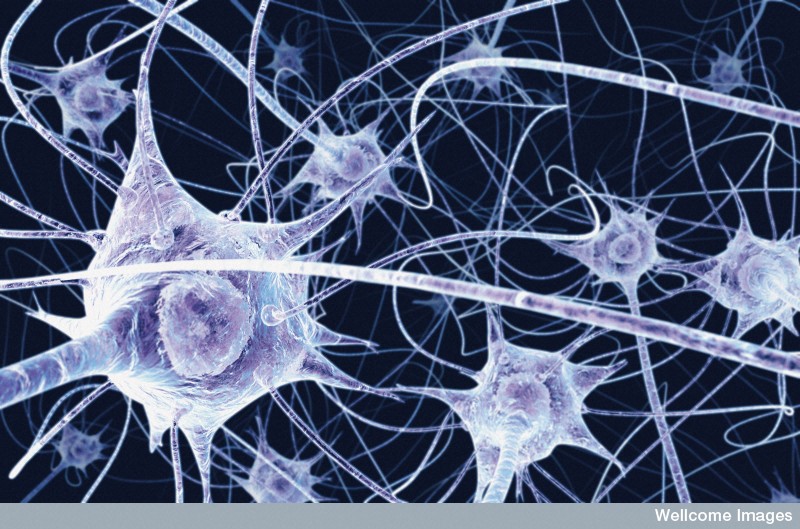Causes of Dopaminergic neuron degeneration.
The cause of the degeneration is not fully understood. Explanations include free radicals, environmental toxins, viral infection, and also a patients genetic predisposition. It is becoming increasingly more likely that the disease results from a combination factors and it is thought that variations in the extent of interactions and risk factors can lead to the variability of symptoms and severity in the disease.
Oxidative stress:
- MPTP or1-methyl-4-phenyl-1,2,3,6-tetrahydropyridine is a neurotoxin. As a lipophilic molecule MPTP can cross the blood-brain barrier.
- LPTP is thought to cause irreversible destruction of nigrostriatal dopaminergic neurons and in primates leads to a Parkinson’s disease-like phenotype. MPTP is converted to the toxic metabolite MPP+ by MAO-B of glial cells and is taken up into the dopaminergic signalling pathway, acting on dopaminergic neurons of the substantia nigra.
- MPP+ interferes with complex 1 of the electron transport chain. In this way this metabolite is able to inhibit mitochondrial oxidation reactions therefore resulting in the build up of free radicals.
- Free radicals are molecules with unpaired electrons and are therefore highly unstable and reactive and contribute to further cell destruction. These molecules result in oxidative stress.
- However MPTP seems to selectively inhibit nigrostriatal neurons via a high affinity uptake process, which occurs at the nerve terminals and which is normally used in the reuptake of dopamine, moving MPP+ into the cell. MPTP however, has no effect on dopaminergic neurons in other areas which are associated with Parkinson’s disease.
- Selegiline, a monoamine oxidase inhibitor can be seen to prevent the metabolism of MPTP to MPP+ due to the inhibition of MAO-B, therefore blocking MPTP-induced neurotoxicity. Due to selegeline's additional role in the treatment of Parkinson’s disease it is thought that MPTP my also be involved in the blocking of metabolic activation of the putative endogenous MPTP-like substance which is known to be involved in causing Parkinson’s disease, perhaps due to dopamine, as oxidation of dopamine can give rise to toxic metabolites. This toxin has been seen to induce Parkinonism in a number of animals.
Environmental toxins:
- Due to the latter MPTP effects on Parkinson’s disease and the link of structural similarities between the toxin and compounds used in insecticides, it has been questioned as to whether these could play a role in the causation of Parkinson’s disease. It was therefore investigated as to whether Parkinson’s disease was more prevalent in the countryside than in city areas where the exposure to insecticides was much less. The studies results indicated a slight increase in the disease in the countryside but the effect was highly limited and the studies therefore inconclusive.
- There has been further research into pesticides and herbicides and whether these could be linked in with the cause of Parkinson’s disease. For example, rotenone was investigated which has been seen to selectively inhibit mitochondrial function in mice and hence cause a Parkinson’s disease-like syndrome. The mice were seen to display both the motor symptoms along with Lewy body-like inclusions in the nigral neurons suggesting that environmental toxins could play a role in the human Parkinson’s disease, as impaired mitochondrial function appears be a feature of human Parkinson’s disease.
Viral infection:
- Parkinsonism has been seen in some cases to be caused as a consequence of viral infection in the brain.
- The hypothesis was formed after an epidemic of encephalitis lethargica whereby a high proportion of these patients were also seen to develop Parkinsonism and it was therefore wondered as to whether all Parkinson’s disease cases could be due to viral infection.
- However, this idea is controversial and many arguments have been put forward to contradict the concept. For example, in Parkinsonism caused by encephalitis there was a lack of lewy bodies, but the disease was rather defined pathologically with the presence of neurofibrillary tangles.

Genetic predisposition:
- Roughly one-fifth of Parkinson's disease patients have at least one relative with parkinsonian symptoms, this therefore suggests that a genetic factor may be involved.
- Several genes that cause symptoms in younger patients have been identified. Most researchers believe however, that most cases are not caused by genetic factors alone and other factors may contribute.
- The strong familial inheritance of the chromosome 4 gene is the first evidence that a gene alteration alone may lead to Parkinson's disease in some people. Abnormalities have been linked with inherited forms of the disease, at seven sites in the genome.
Current research suggests that the loss of dopaminergic neurons in Parkinson’s disease in most cases is caused by a combinatory effect of both environmental and genetic factors, and there is no definitive answer.
Image courtesy of user twenty_questions of Flickr under the creative commons licence.
